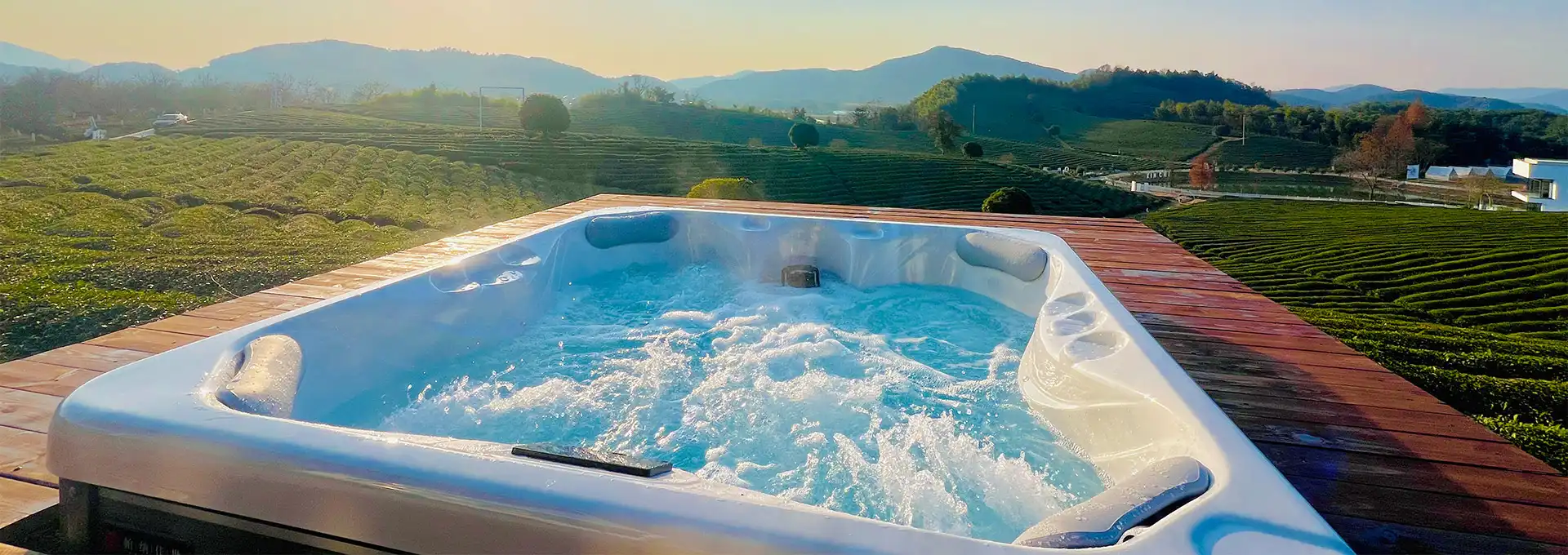Can You Use Baking Soda in Your Swim Spa?
2024-06-21 10:05:44
Using baking soda in your swim spa can be a great way to maintain water quality and keep the environment clean and refreshing. Baking soda, also known as sodium bicarbonate, is a natural and versatile substance that has many applications in household cleaning and personal care products. In the context of a 6 person swim spa, baking soda can be used as a pH balancer, water softener, and deodorizer.
What Are the Benefits of Using Baking Soda in a Swim Spa?
One of the primary benefits of using baking soda in a swim spa is its ability to help maintain the proper pH level of the water. The ideal pH range for a swim spa is between 7.2 and 7.8, which is slightly alkaline. If the pH level drops below this range, the water can become acidic, leading to skin and eye irritation, as well as corrosion of the swim spa components. By adding baking soda to the water, you can raise the pH level and restore it to the desired range.
Maintaining the proper pH level is crucial for several reasons. First, it ensures that the sanitizers used in the swim spa, such as chlorine or bromine, can function effectively. These sanitizers work best in a specific pH range, and if the pH level is too high or too low, their effectiveness can be diminished, increasing the risk of bacterial growth and contamination.
Additionally, proper pH levels help prevent scaling and staining on the swim spa surfaces. When the pH is too high, calcium and other minerals can precipitate out of the water, forming unsightly scale deposits on the walls, floors, and equipment. Conversely, if the pH is too low, it can cause etching and corrosion of the 6 person swim spa components, leading to premature wear and potential equipment failure.
Another advantage of using baking soda in a swim spa is its water softening properties. Hard water, which contains high levels of minerals like calcium and magnesium, can cause scale buildup and reduce the effectiveness of sanitizers. Baking soda helps to soften the water by binding with these minerals, preventing them from forming scale and making the water feel softer and more comfortable on the skin.
Soft water not only feels better on the skin but also helps prevent mineral buildup in the swim spa plumbing and equipment, which can lead to clogs and reduced efficiency. Additionally, soft water can enhance the performance of soap and detergents, allowing them to lather and clean more effectively, which can be beneficial for maintaining a clean and inviting swim spa environment.
Additionally, baking soda can act as a natural deodorizer in a swim spa. Over time, organic matter and bacteria can accumulate in the water, leading to unpleasant odors. Baking soda can help neutralize these odors by absorbing and neutralizing the compounds responsible for the smells, leaving the water fresh and inviting.
Baking soda's deodorizing properties are due to its ability to neutralize acids and absorb odor-causing molecules. When added to the swim spa water, baking soda can help to eliminate unpleasant smells caused by chloramines (a byproduct of chlorine and organic matter), body oils, and other organic contaminants. This not only makes the swim spa experience more pleasant but can also help to prevent the growth of bacteria and algae, which can thrive in environments with high levels of organic matter.
How to Properly Add Baking Soda to Your Swim Spa?
When adding baking soda to your 6 person swim spa, it's important to follow the manufacturer's instructions and guidelines. The amount of baking soda needed will vary depending on the size of your swim spa and the current pH level of the water. Generally, you can start by adding a small amount, such as 1/4 to 1/2 cup of baking soda, and then testing the pH level after allowing the water to circulate for a few hours.
It's essential to dissolve the baking soda completely before adding it to the swim spa. You can do this by mixing it with warm water in a separate container and stirring until it's fully dissolved. Once dissolved, you can pour the baking soda solution directly into the swim spa while the jets are running to ensure even distribution.
After adding the baking soda, it's crucial to test the pH level again and make any necessary adjustments. If the pH level is still too low, you may need to add more baking soda. Conversely, if the pH level is too high, you may need to use an acid-based pH adjuster to lower it.
It's important to note that while baking soda can be an effective pH balancer, it should be used in moderation and in conjunction with other water treatment products and practices. Overuse of baking soda can lead to excessively high pH levels, which can be just as harmful as low pH levels.
Additionally, it's recommended to test the water regularly and adjust the baking soda dosage as needed. Factors such as bather load, weather conditions, and other environmental factors can affect the pH level, so regular monitoring and adjustment is essential for maintaining optimal water quality.
Are There Any Drawbacks to Using Baking Soda in a Swim Spa?
While baking soda is generally safe and effective for use in 6 person swim spas, there are a few potential drawbacks to be aware of.
First, adding too much baking soda can raise the pH level too high, which can lead to cloudy water, skin and eye irritation, and potentially damage the swim spa components. It's essential to follow the manufacturer's instructions and test the pH level regularly to avoid over-adding baking soda.
High pH levels can also impact the effectiveness of sanitizers, as most sanitizers work best within a specific pH range. If the pH level is too high, the sanitizer may not be able to effectively kill bacteria and other pathogens, increasing the risk of waterborne illnesses and infections.
Second, baking soda can potentially interact with other chemicals used in the swim spa, such as chlorine or bromine sanitizers. If not properly balanced, these interactions can reduce the effectiveness of the sanitizers or create byproducts that can be harmful to swimmers.
One potential byproduct of the interaction between baking soda and chlorine is the formation of chloramines. Chloramines are compounds that can cause eye and respiratory irritation, as well as unpleasant odors. While baking soda can help to neutralize chloramines to some extent, it's important to maintain proper sanitizer levels and water balance to minimize their formation.
Finally, while baking soda can help soften water, it may not be as effective as dedicated water softening systems in areas with extremely hard water. In these cases, additional water softening measures may be required.
Hard water can not only contribute to scaling and mineral buildup but also reduce the effectiveness of baking soda as a pH balancer. This is because the calcium and magnesium ions in hard water can react with the baking soda, forming insoluble compounds that can precipitate out of the water and contribute to scaling.
In areas with very hard water, it may be necessary to use a dedicated water softening system, such as an ion exchange resin or salt-based water softener, in addition to using baking soda. These systems can more effectively remove the hardness-causing minerals from the water, allowing the baking soda to work more efficiently as a pH balancer and softener.
Despite these potential drawbacks, many 6 person swim spa owners find that using baking soda in moderation and following proper guidelines can be a safe and effective way to maintain water quality and create a pleasant and refreshing swim spa experience.
If you want to get more information about this product, you can contact us at info@iparnassus.com!
References:
1. "Baking Soda for Pool and Spa Use" - Trouble Free Pool
2. "Using Baking Soda in Your Hot Tub" - Hot Tub Works
3. "How to Use Baking Soda in a Hot Tub" - Spa Depot
4. "Can You Use Baking Soda in a Hot Tub?" - Hot Tub Club
5. "Baking Soda for Spa and Hot Tub Water Care" - In The Swim
6. "The Benefits of Using Baking Soda in a Hot Tub" - Hot Tub Things
7. "Baking Soda for Hot Tubs: Benefits and How to Use It" - Hot Tub Covers Canada
8. "Using Baking Soda in a Hot Tub: Pros and Cons" - Hot Tub Wizard
9. "Baking Soda for Hot Tubs: A Simple and Effective Solution" - Hot Tub Club
10. "The Ultimate Guide to Using Baking Soda in a Hot Tub" - Hot Tub Works
Send Inquiry
Related Industry Knowledge
- Do Hot Tubs Help with Muscle Recovery?
- Can a Swim Spa be a Medical Tax Deduction?
- How to Test Hot Tub Heater?
- Can You Get in a Hot Tub with a Pacemaker?
- How Much Does a Hot Tub Cost?
- Can you exercise in a large hot tub?
- Can I Heat My Hot Tub with the Cover On?
- How Much Would a Swim Spa Cost?
- Can You Put a Swim Spa Inground?
- How to Install a Swim Spa Inground?



